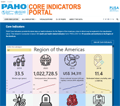
U.S. Virgin Islands - Territory Profile
The Health in the Americas+1 country profiles are based on the interagency indicators available as of the dates referenced. In some cases, the values of the indicators may differ from the most recent data available in the country.
Environmental and social determinants of health
In 2000 the total population of Virgin Islands (U.S.) was 108 579 inhabitants; by 2024 this figure had fallen to 84 905, representing a 21.8% decrease. Regarding the country’s demographic profile, in 2024 people over 65 years of age accounted for 22.7% of the total population, an increase of 14.2 percentage points compared to the year 2000. In 2024, there were 110.1 women per 100 men and 137.5 older people (65 years or older) per 100 children under 15 years of age, as can be seen in the country’s population pyramids, distributed by age group and sex (Figure 1). Considering the population between 15 and 64 years of age to be potentially active (i.e., potential participants in the labor force), this group represented 60.8% of the total population of the country in 2024 ( 51 634 people). When we add these figures to the potentially passive population ( 14 007 under 15 years of age and 19 265 over 65 years of age), the result is a dependency ratio of 64.4 potentially passive people per 100 potentially active people. This ratio was 52.8 in 2000.
Life expectancy at birth in 2024 was 75.7 years, lower than the average for the Region of the Americas and 3.9 years higher that in 2000 (71.8).
Figure 1. Population pyramids, years 2000 and 2024
The unemployment rate in 2023 was 12.3%. Disaggregated by sex, the rate was 13.4% for women and 11.3% for men.
Digital coverage
In 2017, 64.4% of the population had an internet connection, representing a considerable increase from 2000, when 13.8% of the population had an internet connection.
Health situation
Maternal and child health
The proportion of low-birth-weight births (<2,500 grams) increased from 9.1% to 9.9% between 2000 and 2016. In relation to fertility, it is estimated that in 2024 women had an average of 2.1 children throughout their reproductive lives. In the specific case of adolescent fertility, there was a 45.3% decrease, from 57.0 live births per 1000 women aged 15 to 19 years in 2000 to 31.1 in 2024. In 2008, 99.3% of births were attended by skilled birth personnel. Between 2008 and 2015, the percentage of prenatal care coverage with a minimum of 4 consultations, decreased to 91.7% to 50.6%.
The sources of the interagency indicators used in this profile can be found in this table.
 For the latest data on health indicators for the Region of the Americas, be sure to visit the PAHO Core Indicators portal.
For the latest data on health indicators for the Region of the Americas, be sure to visit the PAHO Core Indicators portal.
References
1. Pan American Health Organization. Health in the Americas+. Washington, DC: PAHO; 2022. Available from: https://hia.paho.org
2. World Health Organization. Global excess deaths associated with COVID-19 (modelled estimates). Geneva: WHO; 2022. Available from: https://www.who.int/data/sets/global-excess-deaths-associated-with-covid-19-modelled-estimates.
COUNTRY/TERRITORY PROFILES
Anguilla
Antigua and Barbuda
Argentina
Aruba
Bahamas
Barbados
Belize
Bermuda
Bolivia
Bonaire, Sint Eustatius, and Saba
Brazil (English) (Português)
Canada
Cayman Islands
Chile
Colombia
Costa Rica
Cuba
Curaçao
Dominica
Dominican Republic
Ecuador
El Salvador
French Guiana, Guadeloupe and Martinique
Grenada
Guatemala
Guyana
Haiti (English) (Français)
Honduras
Jamaica
Mexico
Montserrat
Nicaragua
Panama
Paraguay
Peru
Puerto Rico
Saint Kitts and Nevis
Saint Lucia
Saint Vincent and the Grenadines
Sint Maarten
Suriname
Trinidad and Tobago
Turks and Caicos Islands
United States of America
Uruguay
Venezuela
Virgin Islands (British)
Virgin Islands (U.S.)


